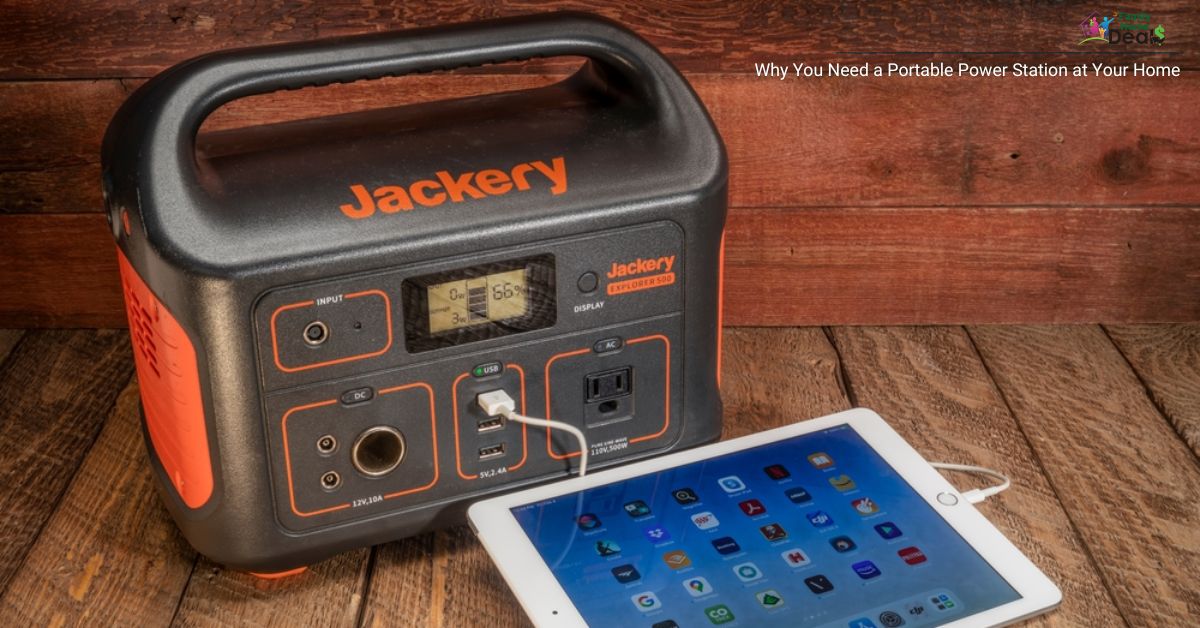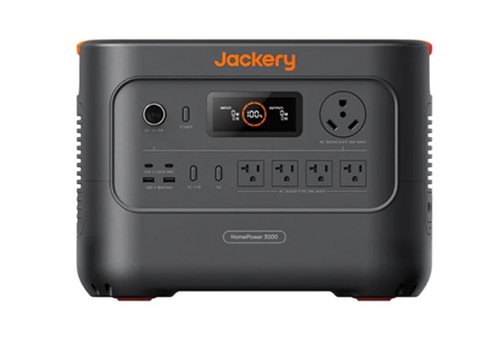
It’s 9 PM. You’re watching your favorite show when suddenly—click—everything goes dark. The hum of your fridge stops. The Wi-Fi drops. Your phone is at 15%. The kids are asking what happened. You scramble for candles, hoping the power comes back soon.
Sounds familiar? You’re not alone. Power outages are becoming more frequent worldwide due to storms, grid failures, and extreme weather. In fact, U.S. households experienced 64% more blackouts in the last decade compared to the one before.
Now imagine a different ending: you calmly grab your portable power station, plug in your router, phone, and a lamp. The fridge keeps running, the kids relax, and life goes on—almost as if nothing happened. That’s the peace of mind you get when you have a portable power station at your home.
This isn’t just about convenience—it’s about safety, resilience, and independence. Let’s explore why a portable power station might be one of the smartest investments you can make for your household.
What Exactly Is a Portable Power Station?
A portable power station is basically a big rechargeable battery that stores electricity and lets you run devices when the grid goes down. Some people call them “solar generators” when paired with panels, but unlike fuel generators, they:
-
Run silently
-
Produce zero emissions
-
Can be used indoors safely
-
Require almost no maintenance
Typical components include:
-
Battery (usually lithium-ion or lithium iron phosphate for longer lifespan)
-
Inverter (converts stored DC into usable AC power)
-
Charging options (wall outlet, solar, or even your car)
-
Output ports (AC outlets, USB, DC)
-
Display panel (battery %, usage time, warnings)
Think of it as a giant power bank for your entire home—but smarter and safer.
Why It’s Important to Have a Portable Power Station at Your Home
1. Peace of Mind During Power Outages
No one likes being at the mercy of the grid. Whether it’s storms, rolling blackouts, or equipment failures, outages are happening more often. With a portable power station, you can keep essentials running:
-
Refrigerator (protecting your groceries)
-
Router/Wi-Fi (for work or staying informed)
-
Phones/tablets (keeping communication alive)
-
Lights and fans
-
Even medical devices (like CPAP machines)
Case Study: During the 2021 Texas blackout, millions were left without power in freezing conditions. Families with portable power stations managed to keep heaters, phones, and medical equipment running—while others struggled in the dangerous cold.
2. Safer Than Fuel Generators
Fuel generators come with big risks: noise, fumes, and the deadly danger of carbon monoxide. Between 1999–2012, there were 739 CO-related deaths linked to generators in the U.S.
Portable power stations? Zero fumes. Zero emissions. You can use them safely indoors without fear.
3. Quiet, Clean, and Hassle-Free
Traditional generators roar like a lawnmower. Portable stations are whisper-quiet—perfect for neighborhoods, apartments, or even in the bedroom. Plus:
-
No refueling cans of gas
-
No oil changes
-
No clogged carburetors
Just plug in, charge up, and go.
4. Portable Power Anywhere You Need It
They’re not just for emergencies. A portable power station at your home can move with you:
-
Camping trips
-
Backyard movie nights
-
Tailgating
-
DIY projects in the garage
-
Remote work outdoors
You’re no longer tied to the wall outlet.
5. Smart Energy Savings
If your utility charges more during “peak hours,” you can charge your power station at night (when rates are cheaper) and use it during expensive times. That’s called peak shaving—and it can cut your bill if you plan smart.
Pair it with solar, and you’re not just saving—you’re making your home more self-sufficient.
6. Eco-Friendly Alternative
Unlike gas generators, portable power stations run clean. No fumes, no pollution, no endless gasoline runs. Charge them with solar panels, and you’re running 100% renewable. Good for your wallet and the planet.
Example Product: Jackery HomePower 3000

To make the ideas more concrete, here’s a detailed example of a portable power station you might pick: the Jackery HomePower 3000.
| Specification | Details |
|---|---|
| Battery Capacity | ~3,072 Wh, Lithium Iron Phosphate (LiFePO₄) |
| Continuous Output Power | 3,600 W AC |
| Surge (Peak) Output | Up to ~7,200 W for short bursts |
| Weight & Size | About 59.5 lb; dimensions approx. 16.4 × 12.8 × 12 in |
| Ports | Multiple AC outlets, USB-C, USB-A, DC ports, 30A TT-30 outlet |
| Charging Options | Fast AC, Hybrid AC + DC (≈1.7 hrs full), Solar DC, Car, Gas generator options |
| Special Features | ZeroDrain™ (keeps ~95% charge after full year of storage), UPS mode with ≤ 20 ms switch time, 5-year warranty |
How Jackery HomePower 3000 Illustrates the Value of a Portable Power Station at Your Home
-
With ~3,072 Wh, it can run a fridge, Wi-Fi/router, and lights for around 1-2 days during an outage, depending on usage.
-
The UPS mode with ≤20 ms switching ensures that sensitive devices (routers, modems, and possibly some medical equipment) won’t reboot or lose data during the transition between grid and backup.
-
The ZeroDrain feature helps in emergency prep because even if you store the unit unused, it won’t lose much power over time. So when a storm hits, it’s ready.
Jackery: Powering Adventures, Anywhere
When it comes to portable power solutions, Jackery leads the charge. Known for innovation and a commitment to sustainability, Jackery delivers more than just power — it delivers peace of mind. From portable power stations and solar panels to smart accessories, every product is designed to bring clean, reliable energy wherever life takes you. Explore the full lineup at jackery.com and discover why outdoor enthusiasts, travelers, and everyday households trust Jackery to keep life moving.
When a Portable Power Station Makes Sense (and When It Doesn’t)
Best For:
✔ Regions with frequent power outages
✔ Families needing backup for essential devices
✔ Apartment dwellers (where gas generators aren’t allowed)
✔ Eco-conscious users wanting solar integration
✔ Outdoor lovers who want power on the go
Not Ideal For:
✘ Running your entire HVAC system
✘ Week-long outages without solar or recharge options
✘ Households with heavy appliances (washer/dryer, electric stove)
Choosing the Right Portable Power Station
Here’s a step-by-step guide to picking the right one:
-
List essentials (fridge, Wi-Fi, lights, phone chargers, etc.)
-
Check their wattage (e.g., fridge ~150W, Wi-Fi ~20W, phone ~10W).
-
Estimate usage time (fridge 10 hrs = 1,500 Wh).
-
Add buffer (20–30%).
-
Pick a station with at least that many watt-hours (Wh).
Example:
| Device | Wattage | Hours Needed | Total Wh |
|---|---|---|---|
| Fridge | 150 W | 10 hrs | 1,500 Wh |
| Wi-Fi | 20 W | 10 hrs | 200 Wh |
| Lights | 10 W × 3 bulbs | 5 hrs | 150 Wh |
| Phone | 10 W | 5 hrs | 50 Wh |
| Total | – | – | 1,900 Wh |
Best match: ~2,000 Wh station
Also check:
-
Inverter size (must handle surge wattage)
-
Battery type (LiFePO₄ lasts 4–6× longer)
-
Charging options (solar, car, AC)
-
Warranty & cycle life
How to Use a Portable Power Station at Home
-
Charge ahead of time (don’t wait for the storm).
-
Place in a cool, well-ventilated area (out of direct sunlight).
-
Connect only essentials first—don’t waste power on TVs during blackouts.
-
Recharge if possible (solar panels are a lifesaver).
-
Maintain regularly: cycle the battery every few months, update firmware if available.
Real-Life Stories
-
A California family used a mid-sized power station to keep their Wi-Fi and fridge on during wildfire-related blackouts—saving hundreds in spoiled food.
-
An asthma patient: Relied on a portable station to keep their medical device running when the power went out overnight.
-
A digital nomad: Keeps one in their van for work calls and camping adventures—doubling as both emergency gear and lifestyle tool.
Mistakes to Avoid
| Mistake | Problem | Fix |
|---|---|---|
| Buying too small | Runs out too quickly | Calculate your watt-hours first |
| Ignoring surge loads | Devices shut off | Match inverter to peak wattage |
| Storing at 100% charge | Shortens battery life | Keep at 80–90% when stored |
| Using outdoors in rain | Risk of damage | Keep dry, use covers |
| Expecting whole-house backup | Leads to disappointment | Use it for essentials only |
Seasonal & Lifestyle Tips
-
Summer: Keep fans and Wi-Fi running during brownouts.
-
Winter: Backup for heaters or medical devices is critical.
-
Travelers: Use it for laptops, drones, or cameras.
-
Eco-users: Pair with solar for off-grid freedom.
FAQs
Q: Can it power my whole house?
A: No. It’s for essentials—fridge, Wi-Fi, phones—not heavy appliances.
Q: How long does it last?
A: Depends on size. A 2,000 Wh unit could run a fridge for 10–15 hours, longer with smart management.
Q: Is it worth the cost?
A: Yes, if outages are common—or if you value security, convenience, and peace of mind.
Q: What’s the best battery type?
A: LiFePO₄ batteries—they last longer, are safer, and more stable.
Don’t Wait for the Next Blackout
Power outages are no longer rare inconveniences—they’re part of modern life. Having a portable power station at your home means you don’t just sit helplessly in the dark; you take control. Whether it’s keeping your groceries safe, staying connected for work, or ensuring medical devices keep running, this is one investment that pays back in comfort, safety, and peace of mind.
Think of it like insurance: you may not use it daily, but when you need it, you’ll be grateful you have it. The next time the lights go out, you’ll be calm, prepared, and—most importantly—still connected. Don’t wait until your fridge spoils or your phone dies. Be ready now.



